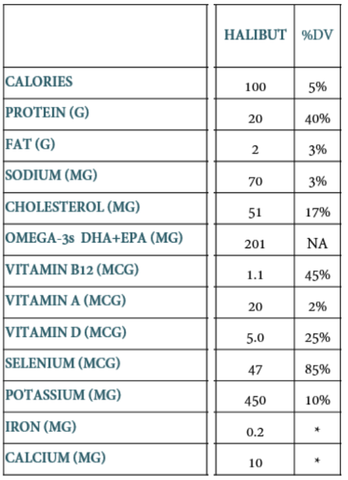All About Our Halibut
Product Info
Halibut
- Caught: mid March- early November
- Location: SE Alaska
- Method: Longline (hook and line)
- Vacuum-packed & flash frozen in 6-8 oz portions
- 5 lb box dimensions: 12” x 10 ⅜” x 4 ⅝”
- 10 lb box dimensions: 15” x 10 ¼” x 6½”
- Generally holds up to 2 years
All About Halibut
Halibut is a common name given to flatfish, but generally refers to Atlantic and Pacific Halibut (Alaskan Halibut is Pacific Halibut from the Alaskan region). The word is derived from the middle English term, haly (“holy”) and butte (“flat fish”), as Halibut was a traditional favorite in Catholic festivities. Halibut are demersal fish, meaning they live on sandy, gravel, or clay bottoms at depths of between 160 and 6,560 feet, while they are most commonly caught around 600 feet in the Pacific. They are dark brown on the top side with a light underbelly and have very small scales invisible to the naked eye embedded in their skin. The Pacific Halibut is the world's largest flatfish, potentially growing up to 500 pounds over a lifespan of up to 50 years. Halibut are strong swimmers and are able to migrate long distances. This gives the meat a firm and dense texture. Halibut have a relatively slow growth rate, with males first reaching sexual reproductive maturity at seven years and females at ten years.
Alaska Select’s Halibut
Pacific Halibut of the Alaskan region, also known as Alaskan Halibut, spawn in deep water where females will lay anywhere from 500,000 to 4 million eggs, depending on their size. Each embryo is about the size of a pea and floats through the water for two weeks before hatching into larva. The larva sustains itself on yolk sac for six months while it slowly drifts upward on counter-clockwise ocean currents around the Northeast Pacific Ocean. As post-larva, their fins and internal organs begin to develop as they float near the surface of the water and feed on plankton. During this stage, the left eye slowly moves over the top of the head to the right side of the fish, which will face upward! The new upside side darkens to match the ocean floor from above, while the underside remains white to blend into the light of the sky from below. Young fish eventually settle at the bottom in shallow feeding areas. After another two to three years, halibut head back out to the deep sea where they feed on cod, pollock, herring, octopus, crabs, shrimp, and other rocky bottom prey. After 10 or 11 years of age, the females will spawn at the place of their birth.
From November to March, mature halibut (fair game for fishing) home along the edge of the continental shelf, between 600 to 1,500 feet. Alaska Select specifically buys 20-40 pound halibut for the health of the fish, the taste and the texture. Longlining is the primary commercial fishing gear used. The technique uses a long line, called the main line, with short length lines (most commonly called snoods) branching off with baited hooks at the end. Anywhere from a handful to thousands of baited hooks can hang from a single line. The Alaska commercial longline fishery has been managed under an Individual Fishery Quota (IFQ) system since 1995. It was put into place to end the “race for fish,” and has resulted increased stability and longer seasons. The North Pacific Fishery Management Council (NPFMC) is responsible for allocating the halibut resource among user groups fishing off Alaska, where Alaska Select sources its halibut. The National Oceanic and Atmospheric Association (NOAA) reports that the Alaskan Halibut population has been increasing since 2013, and is now above target population levels.
Health Benefits of Alaskan Halibut
Halibut is rich in nutrients such as omega-3 essential fatty acids, vitamin A, B6 and B12, niacin, selenium, magnesium, amino acids, phosphorus and potassium.
- Omega-3 fatty acids provide cardiovascular benefits such as preventing erratic heart rhythms, aiding blood flow inside arteries where clots can cause heart attacks, and balancing the ratio of good High Density Lipoprotein (also preventing atherosclerosis). Omega-3s reduce triglycerides, a potentially harmful fat in our bloodstream. Omega-3s also reduce inflammation, which is a key component in the processes that turns cholesterol into artery-clogging plaques.
- Vitamin A is the umbrella term for several fat-soluble compounds. These compounds are vital to many processes in the body, such as the maintenance of healthy vision, immune system functions, organ upkeep, and growth and development during pregnancy.
- Vitamin B12 and vitamin B6 help lower levels of homocysteine, reducing damage to artery walls.
- Niacin (Vitamin B-3) is essential to the entire body’s functioning. Niacin can help lower cholesterol, ease and even prevent arthritis, and boost brain function.
- Selenium acts as a powerful antioxidant, supporting liver function, in turn detoxifying and clearing potentially harmful compounds such as pesticides, drugs, and heavy metals from the body. Selenium reduces risk of chronic diseases like heart disease, Alzheimer’s disease and cancer, combating premature aging and risk of stroke.
- Magnesium lessens improves the flow of blood, oxygen, and nutrients throughout the body, resulting in the overall increased health of many systems.
- Phosphorus is a mineral contributing to the build of strong bones and teeth. It also aids in healthy metabolism, or the convergence of food to energy.
- Amino acids are the building blocks of protein, needed for the development of tissues in the body, including muscles. They are the precursors to hormones, immune response, repair, and other molecular essentials for health.
- Potassium is a necessary mineral for muscle movement, a healthy nervous system, and balanced water retention in the body.
Up-to-date nutritional value of Alaskan Halibut (2019), based on a 3 oz (⅔ cup, or 85g) serving serving size:

Culinary Profile of Halibut
Halibut is reputed for its clean taste and sweet cheeks. It is a lean (less fatty) fish with a white flesh, containing few bones. Pacific Halibut (Alaskan especially) has a gentler taste than its Atlantic cousin, and stands up well to bold flavors and a wide range of supplemental ingredients, making it a versatile fish. While its ultra-low fat content makes Halibut more difficult for smoking, it is easily and often boiled, deep-fried or grilled. For a crisp and seasoned outer layer, spread a rub on either or both sides of the fish and sear it in a pan before baking.
Halibut (deriving its name from “Holy flatfish”) has been celebrated as the centerpiece of traditional Catholic holidays for centuries. As a main dish, it pairs well with a variety of grains, potatoes, and vegetables. It is a common upper-end choice for specialty sandwiches or “fish and chips.”
Check out our Halibut recipes!

